
| ©Copyright 2002-2008 [Shawn Nacol] All rights reserved |
editor’s notes by S.T. Joshi from The Call of Cthulhu and Other Weird Tales by H.P. Lovecraft
HPL: the brief biography Lovecraft, H(oward) P(hillips) (1890-1937), American writer of fantasy and horror
His wrote stories of ghoul changelings, psychic possession, unspeakable evil, and mythical worlds in which time and space are dislocated. A recurring theme in his tales was that of a supremely powerful force of evil, Great Cthulhu, who lay dormant underground and awaited the time when he would return to power and lay waste to the Earth.
HPL: the substantive biography
Howard Phillips Lovecraft was born at 9 a.m. on August 20, 1890, at his family home at 454 (then numbered 194) Angell Street in Providence, Rhode Island. His mother was Sarah Susan Phillips Lovecraft, who could trace her ancestry to the arrival of George Philips to Massachusetts in 1630. His father was Winfield Scott Lovecraft, a traveling salesman for Gorham & Co., Silversmiths, of Providence. For several years, Sarah Lovecraft dressed her infant son as a proper Victorian girl in lace and curls, and when Winfield finally cut the boy's hair she raged and wept. When Lovecraft was three his father suffered a nervous breakdown in a hotel room in Chicago and was brought back to Butler Hospital, where he remained for five years before dying on July 19, 1898. Lovecraft was apparently informed that his father was paralyzed and comatose during this period, but the surviving evidence suggests that this was not the case; it is nearly certain that Lovecraft's father died of paresis, a form of syphilis. With the death of Lovecraft's father, the upbringing of the boy fell to his mother, his two aunts, and especially his grandfather, the prominent industrialist Whipple Van Buren Phillips. Lovecraft was a precocious youth: he was reciting poetry at age two, reading at age three, and writing at age six or seven. His earliest enthusiasm was for the Arabian Nights, which he read by the age of five; it was at this time that he adapted the pseudonym of "Abdul Alhazred", who later became the author of the mythical Necronomicon. The next year, however, his Arabian interests were eclipsed by the discovery of Greek mythology, gleaned through Bulfinch's Age of Fable and through children's versions of the Iliad and Odyssey. indeed his earliest surviving literary work, "The Poem of Ulysses" (1897), is a paraphrase of the Odyssey in 88 lines of internally rhyming verse. But Lovecraft had by this time already discovered weird fiction, and his first story, the non-extant "The Noble Eavesdropper", may date to as early as 1896. His interest in the weird was fostered by his grandfather, who entertained Lovecraft with off-the-cuff weird tales in the Gothic mode.
In 1904 the death of Lovecraft's grandfather, and the subsequent mismanagement o his property and affairs, plunged Lovecraft's family into severe financial difficulties. Lovecraft and his mother were forced to move out of their lavish Victorian home into cramped quarters at 598 Angell Street. Lovecraft was devastated by the loss of his birthplace, and apparently contemplated suicide, as he took long bicycle rides and looked wistfully at the watery depths of the Barrington River. But the thrill of learning banished those thoughts. In 1908, however, just prior to his graduation from high school, he suffered a nervous breakdown that compelled him to leave school without a diploma; this fact, and his consequent failure to enter Brown University, were sources of great shame to Lovecraft in later years, in spite of the fact that he was on of the most formidable autodidacts of his time. From 1903 to 1913 Lovecraft was a virtual hermit, doing little save pursuing his astronomical interests and his poetry writing. During this whole period Lovecraft was thrown into an unhealthily close relationship with his mother, who was still suffering from the trauma of her husband's illness and death, and who developed a pathological love-hate relationship with her son. Lovecraft emerged from his hermitry in a very peculiar way. Having taken to reading the early "pulp" magazines of the day, he became so incensed at the insipid love stories of one Fred Jackson in The Argosy the he wrote a letter, in verse, attacking Jackson. This letter was published in 1913, and evoked a storm of protest from Jackson's defenders. Lovecraft engaged in a heated debate in the letter column of The Argosy and its associated magazines, Lovecraft's responses being almost always in rollicking heroic couplets reminiscent of Dryden and Pope. This controversy was noted by Edward F. Daas, President of the United Amateur Press Association (UAPA), a group of amateur writers from around the country who wrote and published their own magazines. Daas invited Lovecraft to join the UAPA, and Lovecraft did so in early 1914. Lovecraft published thirteen issues of his own paper, The Conservative (1915-1923), as well as contributing poetry and essays voluminously to other journals. Later Lovecraft became President and Official Editor of the UAPA, and also served briefly as President of the rival Nation Amateur Press Association (NAPA). This entire experience may well have saved Lovecraft from a life of unproductive reclusiveness; as he himself once said: "In 1914, when the kindly hand of amateurdom was first extended to me, I was a close to the state of vegetation as any animal well can be ... With the advent of the United I obtained a renewal to live; a renewed sense of existence as other than a superfluous weight; and found a sphere in which I could feel that my efforts were not wholly futile. For the first time I could imagine that my clumsy gropings after art were a little more then faint cries lost in the unlistening world." It was in the amateur world that Lovecraft recommenced the writing of fiction, which he had abandoned in 1908. W. Paul Cook an others, nothing the promise shown in such early It was in the amateur world that Lovecraft recommenced the writing of fiction, which he had abandoned in 1908. W. Paul Cook and others, noting the promise shown in such early tales as "The Beast in the Cave" (1905) and "The Alchemist" (1908), urged Lovecraft to pick up his fictional pen again. This Lovecraft did, writing "The Tomb" and "Dagon" in quick succession in the summer of 1917. Thereafter Lovecraft kept up a steady if sparse flow of fiction, although until at least 1922 poetry and essays were still his dominant mode of literary expression. Lovecraft also became involved in an ever-increasing network of correspondence with friends and associates, and he eventually became one of the greatest and most prolific letter-writers of the century.
Although Lovecraft had many friends in New York--Frank Belknap Long, Rheinhart Kleiner, Samuel Loveman--he became increasingly depressed by his isolation and the masses of "foreigners" in the city. His fiction turned from the nostalgic ("The Shunned House" (1924) is set in Providence) to the bleak and misanthropic ("The Horror at Red Hook" and "He" (both 1924) lay bare his feelings for New York). Finally, in early 1926, plans were made for Lovecraft to return to the Providence he missed so keenly. But where did Sonia fit into these plans? No one seemed to know, least of all Lovecraft. Although he continued to profess his affection for her, he acquiesced when his aunts barred her from coming to Providence to start a business; their nephew could not be tainted by the stigma of a tradeswoman wife. The marriage was essentially over, and a divorce in 1929 was inevitable. When Lovecraft returned to Providence on April 17, 1926, settling at 10 Barnes Street north of Brown University, it was not to bury himself away as he had done in the 1908-13 period; The last two or three years of his life, however, were filled with hardship. In 1932 his beloved aunt, Mrs. Clark, died, and he moved into quarters at 66 College Street, right behind the John Hay Library, with his other aunt Mrs. Gamwell in 1933. (This house has now been moved to 65 Prospect Street.) His later stories, increasingly lengthy and complex, became difficult to sell, and he was forced to support himself largely through It is likely that, as he saw death approaching, Lovecraft envisioned the ultimate oblivion of his work: he had never had a true book published in his lifetime (aside, perhaps, from the crudely issued The
For more information on Lovecraft, I encourage you to visit the excellent HP Lovecraft archive at www.hplovecraft.com.
Plaque dedicated to Lovecraft, located outside the John Hay Library on the Brown University Campus, where Lovecraft's papers reside. The text is from Lovecraft's Fungi from Yuggoth, Sonnet XXX. The silhouette was made by an artist at Coney Island in 1926. |
|


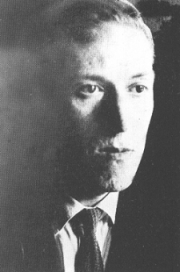 Born in Providence, Rhode Island, August 20, 1890, Lovecraft was a sickly, precocious child whose parents died insane. Despite turbulent formative years, Lovecraft showed a great aptitude for literature, reading prolifically and supposedly writing his first story around the age of six; at the age of 16 he was writing an astronomy column for the Providence Tribune. Following the death of his grandfather in 1904 (who had effectively taken over the role of father figure for the young boy), Lovecraft was forced into a period of financial hardship and subsequently fell into mental decline, suffering a nervous breakdown at the age of 18 in 1908. From 1908 until 1923 he eked out a livelihood and occasionally published stories in amateur magazines. He became increasingly interested in ‘pulp’ magazines, eventually sold a number of them to Weird Tales, which was to become the primary market for his fiction. His stories never earned him much, however, and he died in Providence on March 15, 1937 in poverty and obscurity, convinced that his life had been a failure. About a decade later, his work began to receive serious attention.
Born in Providence, Rhode Island, August 20, 1890, Lovecraft was a sickly, precocious child whose parents died insane. Despite turbulent formative years, Lovecraft showed a great aptitude for literature, reading prolifically and supposedly writing his first story around the age of six; at the age of 16 he was writing an astronomy column for the Providence Tribune. Following the death of his grandfather in 1904 (who had effectively taken over the role of father figure for the young boy), Lovecraft was forced into a period of financial hardship and subsequently fell into mental decline, suffering a nervous breakdown at the age of 18 in 1908. From 1908 until 1923 he eked out a livelihood and occasionally published stories in amateur magazines. He became increasingly interested in ‘pulp’ magazines, eventually sold a number of them to Weird Tales, which was to become the primary market for his fiction. His stories never earned him much, however, and he died in Providence on March 15, 1937 in poverty and obscurity, convinced that his life had been a failure. About a decade later, his work began to receive serious attention.
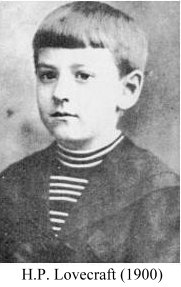 As a boy Lovecraft was somewhat lonely and suffered from frequent illnesses, many of them apparently psychological. his attendance at the Slater Avenue School was sporadic, but Lovecraft was soaking up much information through independent reading. At about the age of eight he discovered science, first chemistry, then astronomy. He began to produce hectographed journals, The Scientific Gazette (1899-1907) and The Rhode Island Journal of Astronomy (1903-1907), for distribution amongst his friends. When he entered Hope Street High School, he found both his teachers and peers congenial and encouraging, and he developed a number of long-lasting friendships with boys of his age. Lovecraft's first appearance in print occurred in 1906, when he wrote a letter on an astronomical matter to The Providence Sunday Journal. Shortly thereafter he began writing a monthly astronomy column for The Pawtuxet Valley Gleaner, a rural paper; he later wrote columns for The Providence Tribune (1906-1908) and The Providence Evening News (1914-1918), as well as The Asheville (N.C.) Gazette-News (1915).
As a boy Lovecraft was somewhat lonely and suffered from frequent illnesses, many of them apparently psychological. his attendance at the Slater Avenue School was sporadic, but Lovecraft was soaking up much information through independent reading. At about the age of eight he discovered science, first chemistry, then astronomy. He began to produce hectographed journals, The Scientific Gazette (1899-1907) and The Rhode Island Journal of Astronomy (1903-1907), for distribution amongst his friends. When he entered Hope Street High School, he found both his teachers and peers congenial and encouraging, and he developed a number of long-lasting friendships with boys of his age. Lovecraft's first appearance in print occurred in 1906, when he wrote a letter on an astronomical matter to The Providence Sunday Journal. Shortly thereafter he began writing a monthly astronomy column for The Pawtuxet Valley Gleaner, a rural paper; he later wrote columns for The Providence Tribune (1906-1908) and The Providence Evening News (1914-1918), as well as The Asheville (N.C.) Gazette-News (1915).
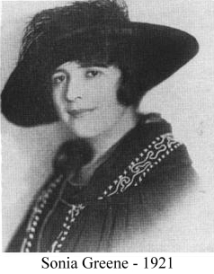 Lovecraft's mother, her mental and physical condition deteriorating, suffered a nervous breakdown in 1919 and was admitted to Butler Hospital, whence, like her husband, she would never emerge. Her death on May 24, 1921, however was the result of a bungled gall bladder operation. Lovecraft was shattered by the loss of his mother, but in a few weeks had recovered enough to attend an amateur journalism convention in Boston on July 4, 1921. It was on this occasion that he first met the woman who would become his wife. Sonia Haft Greene was a Russian Jew seven years Lovecraft's senior, but the two seemed, at least initially, to find themselves very congenial. Lovecraft visited Sonia in her Brooklyn apartment in 1922, and the news of their marriage on March 3, 1924, was not entirely a surprise to their friends; but it may have been to Lovecraft's two aunts, Lillian D. Clark and Annie E. Phillips Gamwell, who were notified only by letter after the ceremony had taken place. Lovecraft moved into Sonia's apartment in Brooklyn, and initial prospects for the couple seemed good: Lovecraft had gained a foothold as a professional writer by the acceptance of several of his early stories by Weird Tales, the celebrated pulp magazine founded in 1923; Sonia had a successful hat shop on Fifth Avenue in New York.
Lovecraft's mother, her mental and physical condition deteriorating, suffered a nervous breakdown in 1919 and was admitted to Butler Hospital, whence, like her husband, she would never emerge. Her death on May 24, 1921, however was the result of a bungled gall bladder operation. Lovecraft was shattered by the loss of his mother, but in a few weeks had recovered enough to attend an amateur journalism convention in Boston on July 4, 1921. It was on this occasion that he first met the woman who would become his wife. Sonia Haft Greene was a Russian Jew seven years Lovecraft's senior, but the two seemed, at least initially, to find themselves very congenial. Lovecraft visited Sonia in her Brooklyn apartment in 1922, and the news of their marriage on March 3, 1924, was not entirely a surprise to their friends; but it may have been to Lovecraft's two aunts, Lillian D. Clark and Annie E. Phillips Gamwell, who were notified only by letter after the ceremony had taken place. Lovecraft moved into Sonia's apartment in Brooklyn, and initial prospects for the couple seemed good: Lovecraft had gained a foothold as a professional writer by the acceptance of several of his early stories by Weird Tales, the celebrated pulp magazine founded in 1923; Sonia had a successful hat shop on Fifth Avenue in New York.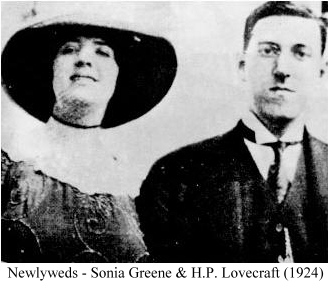 But troubles descended upon the couple almost immediately: the hat shop went bankrupt, Lovecraft turned down the chance to edit a companion magazine to Weird Tales (which would have necessitated his move to Chicago), and Sonia's health gave way, forcing her to spend time in a New Jersey sanitarium. Lovecraft attempted to secure work, but few were willing to hire a thirty-four-year-old-man with no job experience. On January 1, 1925, Sonia went to Cleveland to take up a job there, and Lovecraft moved into a single apartment near the seedy Brooklyn area called Red Hook.
But troubles descended upon the couple almost immediately: the hat shop went bankrupt, Lovecraft turned down the chance to edit a companion magazine to Weird Tales (which would have necessitated his move to Chicago), and Sonia's health gave way, forcing her to spend time in a New Jersey sanitarium. Lovecraft attempted to secure work, but few were willing to hire a thirty-four-year-old-man with no job experience. On January 1, 1925, Sonia went to Cleveland to take up a job there, and Lovecraft moved into a single apartment near the seedy Brooklyn area called Red Hook.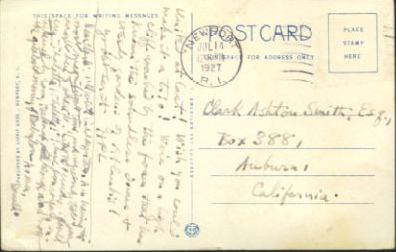 rather, the last ten years of his life were the time of his greatest flowering, both as a writer and as a human being. His life was relatively uneventful--he traveled widely to various antiquarian sites around the eastern seaboard (Quebec, New England, Philadelphia, Charleston, St. Augustine); he wrote his greatest fiction, from "The Call of Cthulhu" (1926) to At the Mountains of Madness (1931) to "The Shadow out of Time" (1934-35); and he continued his prodigiously vast correspondence--but Lovecraft had found his niche as a New England writer of weird fiction and as a general man of letters. He nurtured the careers of many young writers (August Derleth, Donald Wandrei, Robert Bloch, Fritz Leiber); he became concerned with political and economic issues, as the Great Depression led him to support Roosevelt and become a moderate socialist; and he continued absorbing knowledge on a wide array of subjects, from philosophy to literature to history to architecture.
rather, the last ten years of his life were the time of his greatest flowering, both as a writer and as a human being. His life was relatively uneventful--he traveled widely to various antiquarian sites around the eastern seaboard (Quebec, New England, Philadelphia, Charleston, St. Augustine); he wrote his greatest fiction, from "The Call of Cthulhu" (1926) to At the Mountains of Madness (1931) to "The Shadow out of Time" (1934-35); and he continued his prodigiously vast correspondence--but Lovecraft had found his niche as a New England writer of weird fiction and as a general man of letters. He nurtured the careers of many young writers (August Derleth, Donald Wandrei, Robert Bloch, Fritz Leiber); he became concerned with political and economic issues, as the Great Depression led him to support Roosevelt and become a moderate socialist; and he continued absorbing knowledge on a wide array of subjects, from philosophy to literature to history to architecture. the "revision" or ghost-writing of stories, poetry, and nonfictions works. In 1936 the suicide of Robert E. Howard, one of his closest correspondents, left him confused and saddened. By this time the illness that would cause his own death--cancer of the intestine--had already progressed so far that little could be done to treat it. Lovecraft attempted to carry on in increasing pain through the winter of 1936-37, but was finally compelled to enter Jane Brown Memorial Hospital on March 10, 1937, where he died five days later. He was buried on March 18 at the Phillips family plot at Swan Point Cemetery.
the "revision" or ghost-writing of stories, poetry, and nonfictions works. In 1936 the suicide of Robert E. Howard, one of his closest correspondents, left him confused and saddened. By this time the illness that would cause his own death--cancer of the intestine--had already progressed so far that little could be done to treat it. Lovecraft attempted to carry on in increasing pain through the winter of 1936-37, but was finally compelled to enter Jane Brown Memorial Hospital on March 10, 1937, where he died five days later. He was buried on March 18 at the Phillips family plot at Swan Point Cemetery. Shadow over Innsmouth [1936]), and his stories, essays, and poems were scattered in a bewildering number of amateur or pulp magazines. But the friendships that he had forged merely by correspondence held him in good stead: August Derleth and Donald Wandrei were determined to preserve Lovecraft's stories in the dignity of a hardcover book, and formed the publishing firm of Arkham House initially to publish Lovecraft's work; they issued The Outsider and Others in 1939. Many other volumes followed from Arkham House, and eventually Lovecraft's work became available in paperback and was translated into a dozen languages. Today, at the centennial of his birth, his stories are available in textually corrected editions, his essays, poems, and letters are widely available, and many scholars have probed the depths and complexities of his work and thought. Much remains to be done in the study of Lovecraft, but it is safe to say that, thanks to the intrinsic merit of his own work and to the diligence of his associates and supporters, Lovecraft has gained a small but unassailable niche in the canon of American and world literature.
Shadow over Innsmouth [1936]), and his stories, essays, and poems were scattered in a bewildering number of amateur or pulp magazines. But the friendships that he had forged merely by correspondence held him in good stead: August Derleth and Donald Wandrei were determined to preserve Lovecraft's stories in the dignity of a hardcover book, and formed the publishing firm of Arkham House initially to publish Lovecraft's work; they issued The Outsider and Others in 1939. Many other volumes followed from Arkham House, and eventually Lovecraft's work became available in paperback and was translated into a dozen languages. Today, at the centennial of his birth, his stories are available in textually corrected editions, his essays, poems, and letters are widely available, and many scholars have probed the depths and complexities of his work and thought. Much remains to be done in the study of Lovecraft, but it is safe to say that, thanks to the intrinsic merit of his own work and to the diligence of his associates and supporters, Lovecraft has gained a small but unassailable niche in the canon of American and world literature.










